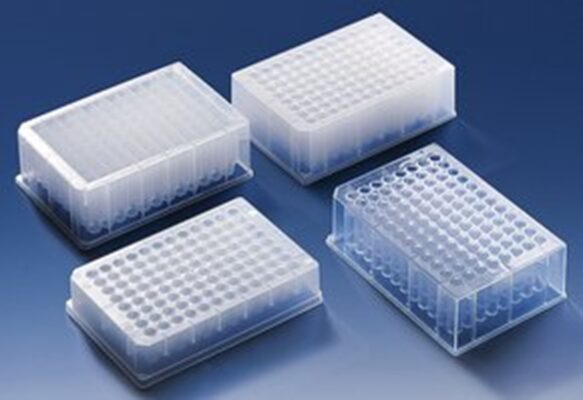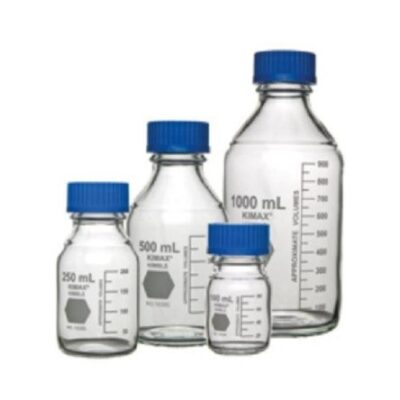Centrifuges
What is a centrifuge
A centrifuge is a device that uses centrifugal force to separate various components of a fluid. This is achieved by spinning the fluid at high speed within a container, thereby separating fluids of different densities (e.g. cream from milk) or liquids from solids. It works by causing denser substances and particles to move outward in the radial direction. At the same time, objects that are less dense are displaced and move to the centre. In a laboratory centrifuge that uses sample tubes, the radial acceleration causes denser particles to settle to the bottom of the tube, while low-density substances rise to the top.[1] A centrifuge can be a very effective filter that separates contaminants from the main body of fluid.
Revolutions Per Minute (RPM)
Revolutions Per Minute (RPM) in regards to centrifugation is simply a measurement of how fast the centrifuge rotor does a full rotation in one minute. Basically, it is telling us how fast the rotor is spinning. Centrifuges will have a speed range that they are capable of achieving and will vary depending on the centrifuge. A low speed centrifuge might spin at as low as 300 RPM, whilst a high speed centrifuge could spin up to 15000 RPM. Ultracentrifuges are also available and are the most powerful type of centrifuge, they can spin in excess of 150,000 RPM.
Relative Centrifugal Force (RCF)
Relative Centrifugal Force (RCF) or g-force (both are the same, RCF is expressed as units of gravity) is a measurement of the gravitational force that a sample is subject to. The force is generated from the spinning of the rotor which, in turn, exerts this force outward on the centrifuge tube. Not only does RCF take into account the speed of rotation, it also measures the distance from the centre of rotation to give us a g-force measurement. RCF is the preferred method of measurement as it will remain the same even if you are using a different centrifuge with a different rotor size.
How to calculate RPM to RCF,
RCF = (RPM)2 × 1.118 × 10-5 × r
Radius of Rotor GAS-25(500) = 138.3 mm (13.83cm) :
Therefore
RCF = (10,000)2 × 1.118 × 0,00001 × (13.83cm) (radius for GAS-25(500) = 15,462 xg
Calculator
Fixed-angle rotor
The obvious advantage is the lack of moving parts in the rotor. This results in lower metal stress (longer lifetime), a higher maximum g-force is possible and for many applications, faster centrifugation times can be realized. The limited capacity (less flexibility) of the fixed-angle rotor is the only drawback. The position of the pellet strongly depends on the angle of the tube, it is located from the side to the bottom of the tube when spinning. Most rotors have a 45° angle for the tubes. The larger the angle for the tubes, the tighter the pellet. Smaller rotor angles result in more spread out pellet areas.
Swing-bucket rotor
This kind of rotor is highly flexible for using different tube formats, including SBS-format plates, based on a broad range of adapter systems and a high sample capacity. The moving swing-bucket parts result in increased metal stress for the rotor and the buckets as the bucket weight places a load on the two pivots and grooves. Compared with a fixed-angle rotor, therefore, a swing-bucket rotor is limited to a lower maximum g-force, which leads to longer centrifugation times. Based on the swing-bucket principle, the pellet is located in the bottom of the tube (horizontal position of tube during the run). The recovery by the user is facilitated compared to pellets located at the side of the tube.
What are adapters?
To fit different vessels into one bucket (for swing-out rotors) and ensure that a wide variety of tubes can be accommodated, it is often necessary to use an adapter designed for the specific vessel. These adapters are inserted into the bucket. https://handling-solutions.eppendorf.com/sample-handling/centrifugation/this-and-that/detailview/news/centrifugation-tube-adapters-when-to-use-one-and-how-to-identify-the-correct-one/
Centrifugation at Different Temperatures
Centrifugation generates heat, which can increase the temperature within a centrifuge (sometimes, by more than 15°C). This can affect the stability of temperature-sensitive samples. In such cases, refrigerated centrifuges are usually preferred. However, constant temperatures can also be maintained in an ambient centrifuge. The sample temperature during centrifugation is primarily influenced by three factors: rotor material, rotor shape, and speed of rotation.
What is Deceleration?
During centrifugation, separation of the sample components continues during the deceleration phase. Many centrifuges offer the option to control deceleration settings (brakes) to bring it to a stop faster, but when do we really need this option, and what is the effect on sample outcomes?
Braking can be particularly useful during centrifugations involving nucleic acid extractions or bacterial cell pelleting, which are not affected by sudden stopping. However, for experiments that are more sensitive to abrupt deceleration, such as isolation of peripheral blood mononuclear cells and gradient centrifugations, braking can cause separated layers to remix. In such cases, it is more suitable to turn off the brake so that deceleration is gradual and does not disturb the gradients. Some centrifuges provide a range of deceleration settings. This can be useful when spinning mammalian cells, which are sensitive to sudden decelerations but, at the same time, require some deceleration to minimize the time taken by the centrifuge to come to a stop.
Types of Centrifuge Tubes

PCR Tubes (0.2ml / 0.4ml)

Microcentrifuge Tubes / Eppies (1.5ml /2ml)

15ml Centrifuge tubes and 50ml Centrifuge tubes Skirted/Unskirted (Falcons)

Blood Tubes 3-10ml

Microplates (MTP and DWP)

Test Tubes

Schott Bottles

Nalgene Bottles
Types of Centrifuges
|
Type |
Common Features |
Our models |
|
Mini Centrifuge |
-Fixed angle rotor -For PCR and microcentrifuge tubes only -6-8 places; +-6000rpm -Some come with a PCR strip rotor -Most models don’t have a start button – works when you close the lid -Most models don’t have speed regulation or deceleration
|
Allsheng: (Under R3k) Mini-6k, Mini-7k, Mini-10k Mini-6KT (48well plate rotor) Mini-6KS Mini-6KC Capp CR-68X or CR-68 Cryste Purispin 6 |
|
Microcentrifuge |
-for 1.5/2ml tubes, some come with PCR adapters or cryotube adapters -12 or 24 place fixed angle rotor – 15000 xg to 24000xg
|
Allsheng Mini-15K Allsheng iCen-24 Capp CR-1512 (12 place, 15000 xg) Cryste Purispin 15 |
|
Refrigerated Microcentrifuge |
-same as above but generally 24 place or more fixed angle rotor – 15000 xg to 24000xg – refrigerated |
Cryste Purispin 17R (also swing out rotor options) Allsheng iCen-24R Cryste Purispin 18R (30000xg, also swing rotor options) Capp 1544R (new product) Capp 1730R |
|
Hematocrit Centrifuge |
-special rotor for capillaries |
No model available with CAPP or Cryste but AHN does one. Contact Preston when you have an enquiry |
|
Microplate Plate Centrifuge |
Be careful of what rcf is required and plate format |
Allsheng Mini-P25 (500xg) Allsheng MPC-P25 (480xg) Cryste Varispin 4 and 6 (2003xg) Varispin 12 onwards (2746xg) Cryste Purispin 18R (2655g) Capp CRC-432X (2366xg) |
|
Clinical Centrifuge
|
-used to separate plasma from blood -Fixed angle rotor -PRP treatment -Low RPM models (generally lower than 4000rpm but 6000rpm models are also available) -For blood tubes or 15ml conical centrifuge tubes
|
Cryste Varispin 4A and 6A Capp CRC-416X |
|
Table top / Benchtop Centrifuge
|
-takes angle and swingout rotors -Most brands have a few models in this range can be distinguished by swing out rotor bucket capacity and refrigerated or ambient models -max rpm angle +/- 15000 |
Cryste Varispin 4 to 15R (from 20 to 96 blood tube capacity)
|
|
Floor Standing Centrifuge / high speed centrifuges
|
-Swing out rotors have large volumes eg. 1-2lt buckets -Angle rotors have large volumes and high speeds. Eg 1lt at 8000rpm or 500ml at 10000rpm -Able to reach high speeds for 15&50ml tubes (up to 22000rpm) -Highly specialized not many competitors in the market as compared to the other ranges |
-Cryste Teraspin and Velospin (our swing our rotors in this range is limited and similar to the Varispin range. Therefore we would only offer this for high speed and high volume angle rotors) |
|
Ultra Centrifuges |
-Up to 1000000 g (typically up to 800000g) -Rpm up to 100000rpm |
We don’t currently have a product in this range. But contact me when you have an enquiry |
|
Cell Washer |
-for performing blood groupings, blood typing, cross matching, ABO compatibility, RH testing and the Coombs tests procedure. |
We don’t currently have a product in this range. But contact me when you have an enquiry |
|
Centrifugal Evaporator |
A centrifugal evaporator is a device used in chemical and biochemical laboratories for the efficient and gentle evaporation of solvents from many samples at the same time |
Labogene Scanvac series |
Swing out rotor for 1.5ml tubes available for Varispin 17R and 18R
Watch out for conical bottoms
Adapter bore and max tube height
Blood bag centrifuges
Questions to ask your customer
- Do you require a refrigerated or ambient centrifuge?
- What are your speed requirements (RCF/RPM)?
- What size/ type of tubes will you be spinning?
- How many tubes at once?
- Do you need a fixed angle or swing out rotor?
- Do you need lids for your rotor?
Further Reading
https://blog.helmerinc.com/5-questions-to-ask-when-selecting-centrifuge
https://www.microscopemaster.com/laboratory-centrifuge.html
https://www.labmanager.com/product-focus/the-basics-of-centrifuge-operation-and-maintenance-1433
